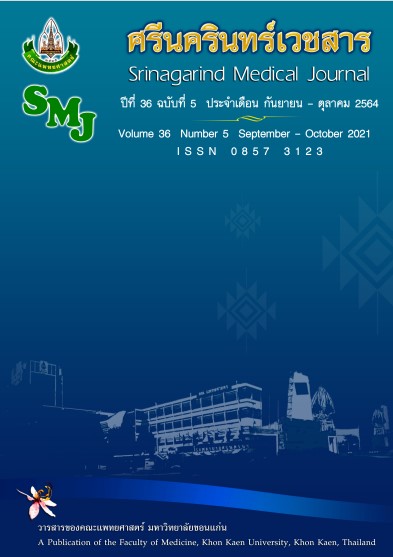ความสม่ำเสมอในการรับประทานยาเม็ดเสริมธาตุเหล็กในระหว่างตั้งครรภ์
Abstract
Compliance of Iron Supplementation During Pregnancy
Romthira Srisai1, Jadsada Thinkhamrop1*, Sukanya Chaiyarach1, Sukanya Kreetiyutanont2
1Department of Obstetrics and Gynecology, Faculty of Medicine, Khon Kaen University
2Department of Nursing, Srinagarind Hospital, Khon Kaen University, Khon Kaen, 40002 Thailand
Received: 9 June 2021 / Edit: 9 July 2021 / Accepted: 4 August 2021
รับ 9 มิ.ย. 64
คืนแก้ไข 9 ก.ค. 64
ตอบรับตีพิมพ์ 4 ส.ค. 64
*Corresponding author: Jadsada Thinkhamrop (ORCID 0000-0002-0260-2131)
Department of Obstetrics and Gynecology, Faculty of Medicine, Khon Kaen University,
123 Mittraphap Highway, Muang Khon Kaen, Khon Kaen 40002, Thailand
Tel: +66 43 202 489, Fax: +66 43 348 395Email: jadsada@kku.ac.th
หลักการและวัตถุประสงค์: เพื่อประเมินความสม่ำเสมอในการรับประทานยาเม็ดเสริมธาตุเหล็ก และระดับฮีโมโกลบินในหญิงตั้งครรภ์ไตรมาสที่ 2 และเมื่อครรภ์ครบกำหนด อันจะเป็นประโยชน์ในการพิจารณาเสริมธาตุเหล็กให้เหมาะสมต่อไป
วิธีการศึกษา: สตรีตั้งครรภ์ครบกำหนดมาคลอดที่โรงพยาบาลศรีนครินทร์ โดยไม่มีภาวะซีดเมื่อมาฝากครรภ์ครั้งแรก ที่ได้รับยาเม็ดเสริมธาตุเหล็กก่อนอายุครรภ์ 20 สัปดาห์ จะได้รับการสัมภาษณ์ถึงความสม่ำเสมอและผลข้างเคียงของยาเม็ดเสริมธาตุเหล็ก ซึ่งความสม่ำเสมอแบ่งออกเป็น 4 กลุ่ม คือ กลุ่มที่รับประทานมากกว่าร้อยละ 80 (6-7 เม็ดต่อสัปดาห์), ร้อยละ 50-80 (3-5 เม็ดต่อสัปดาห์), ร้อยละ 25-50 (2 เม็ดต่อสัปดาห์) และน้อยกว่าร้อยละ 25 (0-1 เม็ดต่อสัปดาห์) ส่วนฮีโมโกลบินในไตรมาสที่ 2 และเมื่อครรภ์ครบกำหนดได้ข้อมูลจากเวชระเบียน
ผลการศึกษา: อาสาสมัคร 350 ราย พบว่า กว่าร้อยละ 80 มีความสม่ำเสมอในการรับประทานยาเม็ดเสริมธาตุเหล็ก 6-7 เม็ดต่อสัปดาห์ มีผลข้างเคียงร้อยละ 10.5, 12.1 และ 66.7 ในกลุ่มที่มีความสม่ำเสมอในการรับประทานมากกว่าร้อยละ 80, ร้อยละ 50-80 และน้อยกว่าร้อยละ 25 ตามลำดับ ผลข้างเคียงที่พบบ่อยคือ คลื่นไส้และท้องผูก
สรุป: สตรีตั้งครรภ์มากกว่าร้อยละ 80 รับประทานยาเม็ดเสริมธาตุเหล็ก 6-7 เม็ดต่อสัปดาห์
คำสำคัญ: การเสริมธาตุเหล็ก; ความสม่ำเสมอ; ผลข้างเคียง; ตั้งครรภ์
Background and objectives: This study aimed to determine the compliance rate of iron supplementation and the hemoglobin concentration in second trimester and at term of pregnant women to take into consideration for the optimal practice.
Methods: The study conducted among term pregnant women admission to the hospital for delivery who had non-anemic status at the initial visit for antenatal care, received daily iron supplementation before 20 weeks of gestation. They were interviewed to obtain the personal data, daily taking the supplemented tablet and side-effects. The compliance rate categorized as >80%, >50-80%, 25-50%, and < 25% according to the women’s response that they took daily tablet of 6-7, 3-5, 2, and 0-1 day(s) in one week, respectively. The laboratory results of hemoglobin level were retrieved from their medical records.
Results: Among 350 participants had the compliance rate of >80%. The common side-effects were nausea and constipation. The side-effect rates were 10.5%, 12.1%, 66.7% in >80%, >50-80%, <25% compliance groups, respectively. While hemoglobin concentrations above 13 gm/dl, which defined as high concentrated hemoglobin, revealed 12% during second trimester, and up to 30% at term in high compliance group.
Conclusions: The pregnant women had compliance rate greater than 80% of taking iron supplementation 6-7 tablet/week.
Keywords: iron supplementation, compliance, side-effects, pregnancy


